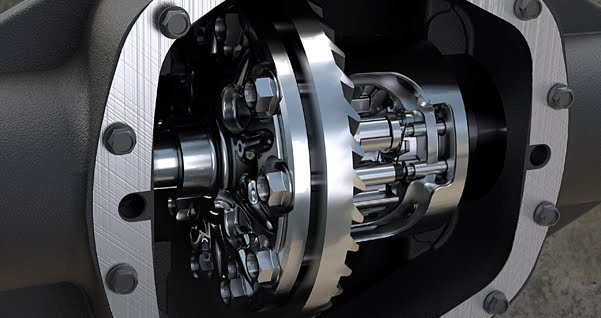Differential – The Torque Transmitter
4 min readThe differential is an inevitable component in all four-wheel vehicles. It is responsible for turning driven wheels at different RPMs when needed. This need arises when the vehicle is taking a turn. During a turn, the outside wheel needs to travel further and faster to cover the distance in the same amount of time as the inside wheel. The differential does the job here.
History:
The conventional automobile differential was invented in 1827 by a Frenchman, Onesiphore Pecqueur. It was first used on steam-driven vehicles and was a well-known device when internal-combustion engines appeared at the end of the 19th century.

In earlier days, single-wheel drive was used, which was not so efficient. Later, a shift was made to two-wheel drive by supplying the power to the shaft holding both wheels. If two wheels are connected with the same shaft, it is called a spool. In the case of a spool, during turning, the use of a single shaft meant that the wheels could not spin independently, and hence, one of the wheels would need to slide. The solution that engineers found is the differential, which would allow each wheel to spin independently.

In a rear-wheel drive setup, the two wheels at the rear are connected by two half shafts to the differential. When the vehicle is on the straights, the wheels rotate at the same speed. In the case of turn-in, the pinion starts rotating on its own and each wheel gets different speeds according to its needs.
Types of Differential Setups:
Open end differential
This type of differential splits the torque produced by the engine into two and transfers the energy to both wheels independently. Hence, when one tyre loses traction, the opposing tyre will also lose traction. It is a basic type of torque transmitter which is very rarely used in vehicles nowadays.

Locking differential
This type of differential is mostly found in trucks and off-road vehicles. The wheels connected to the differential will always spin at the same speed and are dependent on each other, so the vehicle will be hard to turn and it can be used in vehicles that carry a heavy load, where there are high chances of slipping. In some vehicles, there will be a switch to lock the differential during off-roading or any other specific cases.
Limited slip differential
This type of differential is mostly found in passenger and motorsports cars. It is a combination of an open and locking differential. It will act as an open differential in normal cases and automatically locks when slipping occurs. Locking differentials might give you good traction too, but the traction that you will experience with limited slip differentials is better.

Torque vectoring differential
This type of differential is often found in luxury cars. It is designed with excessive gear trains to fine-tune the torque delivered to each wheel. It can slow down or quicken the car’s rotation around the corner. Compared to other differentials, its structure is more complex.
Possibilities of Failure:
Just like other moving parts in the vehicle, differentials also wear and break over time here are some possibilities of differential failure:
- Worn carrier bearings
- Differentials with a loose pinion bearing preload
- When a pinion gear tooth is damaged
- Worn-out U joints
- Broken cornering gears
Differentials typically take differential fluid (or transmission fluid if you have a front-wheel drive vehicle), but there are different types of this oil. The oil itself is designated a gear lubricant number or GL number and works to prevent wear and tear to the integrity of the differential.
Your everyday average differential could take either a GL-4 or a GL-5 oil. There are also special kinds such as GL-5+ and GL-5 LS that are made for specific types of differentials. As for the rate at which you should change the fluid, it’s best to do it every 30,000 to 50,000 miles. Avoiding this can lead to a similar situation as neglecting an oil change and will create a lot of wear and tear on your differential.
Market Analysis:
The global automotive differential market was valued at $20,530.1 million in 2020 and is projected to reach $32,293.6 million by 2030, registering a CAGR of 4-7%. Asia-Pacific was the highest revenue contributor, accounting for $8583.6 million in 2020, and is estimated to reach $14,435.2 million by 2030, with a CAGR of 5.4%.
The differential setup has evolved from just connecting two wheels with the shaft to Electronic slip differential setup, the innovation in the industry is drastically increasing due to the increasing demand of AWD and 4WD vehicles in the market.
References:
https://www.cbac.com/independence/media-center/blog/2016/september/the-four-types-of-car-differentials-explained/
https://www.uti.edu/blog/automotive/differential
https://www.britannica.com/technology/machine
https://www.alliedmarketresearch.com/automotive-differential-market
The following blog post has been written by Arounaachalesvarar B, an autoholic student from the SASTRA deemed University pursuing BTech EEE with a specialization in electric vehicles. Aroun is interested in content creation and blog writing on the automotive industry.
This post has been edited for grammar and other inconsistencies.

